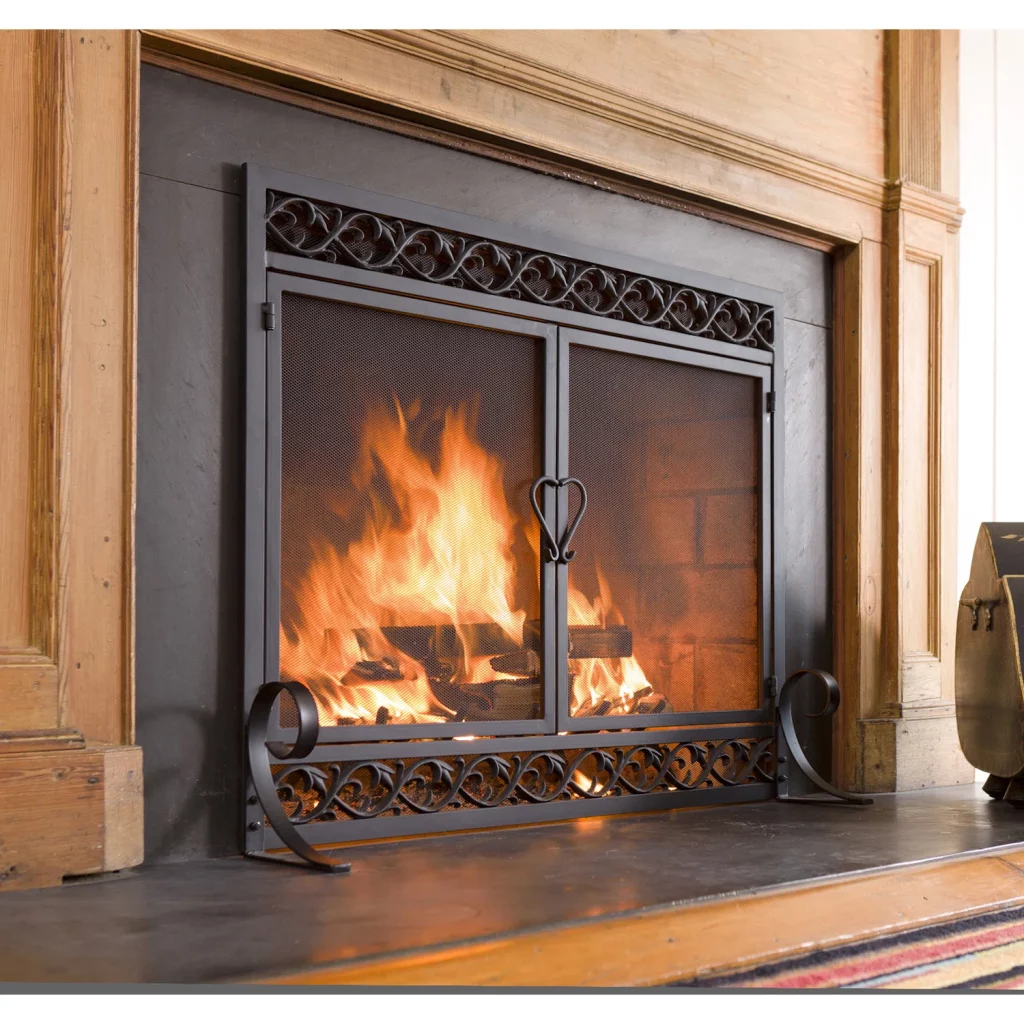Fireplace screens, originally designed for safety and comfort, have roots dating back to the 17th century in Britain. Initially, these screens served the primary function of protecting a room’s occupants from the intense heat of the fireplace, as well as from flying sparks that could cause injury or ignite a fire. However, it didn’t take long for the practicality of the fireplace screen to blend with the era’s artistic sensibilities, transforming these items into canvases for exquisite artwork and craftsmanship.
As the centuries progressed, the design and functionality of fireplace screens evolved, reflecting the changing tastes, technologies, and interior design trends of the times. The Victorian era, known for its emphasis on beauty and ornate details, saw fireplace screens become more elaborate. These screens were often crafted from luxurious materials such as embroidered silk, stained glass, and hand-painted wood, showcasing intricate designs and motifs that reflected the Victorian fascination with nature, mythology, and the exotic.
The Dual Functionality of Antique Fireplace Screens
According to https://www.thornhillgalleries.co.uk/ the most captivating aspect of antique fireplace screens lies in their dual functionality. On one hand, these screens continued to serve their original purpose of heat management and safety. On the other, they became symbols of status and taste, as well as mediums for artistic expression. This blend of practicality and artistry is what makes antique fireplace screens unique.
From a practical standpoint, fireplace screens were essential in managing the living environment. In a time before central heating, the ability to control the heat output from a fireplace was crucial for comfort, especially in the damp and chilly climates of Britain. Screens were strategically placed to shield occupants from the direct heat, allowing for a more pleasant and moderate room temperature. Additionally, the screens protected the room from ash and soot, helping to maintain cleanliness and reduce the need for frequent cleaning.
Artistically, antique fireplace screens are a testament to the craftsmanship and aesthetic preferences of their times. The 18th century, for example, saw the rise of screens adorned with needlework and tapestry, often depicting pastoral scenes or classical motifs. These screens were not only functional items but also served as conversation pieces, showcasing the owner’s taste and the skill of the artisans who created them.
The Evolution of Design
The design of fireplace screens has seen significant evolution, reflecting both technological advancements and changes in interior design trends. Early screens were simple and utilitarian, made from metal or wood. However, as the emphasis on interior decoration grew, so did the variety and complexity of fireplace screen designs.
The 19th century, in particular, was a period of innovation for fireplace screens. The introduction of new materials and techniques allowed for more elaborate designs. Stained glass screens became popular, casting colorful reflections into the room and adding a decorative element even when the fireplace was not in use. Similarly, screens with intricate metalwork or inlaid with mother-of-pearl offered a luxurious touch to the home’s interior.
Moreover, the industrial revolution brought about changes in the way fireplace screens were manufactured. Mass production techniques made it possible to produce screens more efficiently and affordably, increasing their availability and allowing for a greater diversity of designs. This democratization of interior decor meant that more homes could feature the beauty and functionality of these antique screens, regardless of the household’s social status.
The Significance of Antique Fireplace Screens Today
Today, antique fireplace screens are cherished for both their aesthetic appeal and historical value. They serve as a link to the past, offering a glimpse into the domestic lives of earlier generations and the evolution of interior design trends. Collectors and enthusiasts seek out these screens not only for their beauty but also for the stories they tell and the craftsmanship they showcase.
In British homes, antique fireplace screens continue to be used for their original practical purposes, especially in period homes or those with a traditional decor theme. However, they are also appreciated as standalone decorative items, often placed in prominent positions to enhance the interior ambiance and serve as a focal point in a room.
The Social Context of Fireplace Screens
In the social hierarchy of the past, the possession and display of elaborately designed fireplace screens were often indicative of wealth and status. In grand houses and estates, the fireplace was the centerpiece of the living room, around which family and guests gathered for warmth and conversation. Here, the fireplace screen was not just a functional object but a symbol of the homeowner’s sophistication and affluence. The craftsmanship, materials, and art depicted on these screens were carefully chosen to reflect the owner’s tastes and interests, often commissioned from renowned artists and craftsmen of the time.
Furthermore, the use of fireplace screens played a role in the etiquette and social practices of the era. For instance, in the Victorian period, the screen provided a modest shield for ladies to protect their faces from the heat, preserving their complexion which was a matter of societal concern at the time. This functional aspect intertwined with social customs, showcasing how objects within the home were imbued with deeper meanings and uses beyond their apparent purpose.
The Artistic Value of Fireplace Screens
Artistically, antique fireplace screens are celebrated for their diverse range of styles and motifs, reflecting the artistic movements and cultural influences of their times. From the Rococo and Georgian periods to the Victorian and Edwardian eras, each screen tells a story through its design. The Rococo screens, with their light, ornamental designs, contrast with the Gothic revival screens, which feature heavier, medieval-inspired themes. This variation not only illustrates the changing tastes in art and decor but also highlights the adaptability of the fireplace screen as an object of artistic expression.
Collectors and museums today value these screens not only as decorative items but as artifacts of material culture. They offer insights into the technological advancements in metalworking, glass production, and other crafts. For instance, the transition from hand-painted wooden screens to those adorned with machine-embroidered fabrics speaks volumes about the industrial advancements of the 19th century.
Preservation and Restoration
The preservation and restoration of antique fireplace screens have become a passion for many enthusiasts. Given their age and the materials from which they were made, many of these screens require careful maintenance to retain their beauty and structural integrity. Restoration experts specialize in techniques that respect the original craftsmanship, ensuring that repairs are done in a way that honors the screen’s historical and aesthetic value. This dedication to preservation allows future generations to appreciate these artifacts, understanding their place in history and art.
Modern Uses and Inspirations
While antique fireplace screens are revered for their historical and artistic significance, they also inspire contemporary design. Modern interior designers often draw on the aesthetic qualities of these antiques, incorporating them into diverse settings that blend traditional and contemporary decor. Some designers repurpose antique screens as unique pieces of art, wall decorations, or even as headboards, integrating them into the modern home in innovative ways.
Moreover, contemporary craftspeople and artists look to the intricate designs and craftsmanship of antique screens for inspiration, creating new works that echo the past’s elegance and attention to detail. These modern interpretations pay homage to the tradition of fireplace screens while adapting them to fit contemporary tastes and practical needs.
Conclusion
Beyond their beauty and craftsmanship, fireplace screens serve as cultural artifacts, offering insights into the past and continuing to inspire the present. As objects of both historical significance and artistic value, they remind us of the enduring human desire to blend the practical with the beautiful, creating objects that serve not just a functional purpose but also bring beauty and art into the everyday life.











